
|

|
Civil War Firearm and Small Arms Glossary
Pistols, Rifles, Carbines, Shotguns, Muskets
Civil War Glossary and Terminology
Side arms, Handguns, Revolvers, Rifles
| Civil War Gun Glossary |
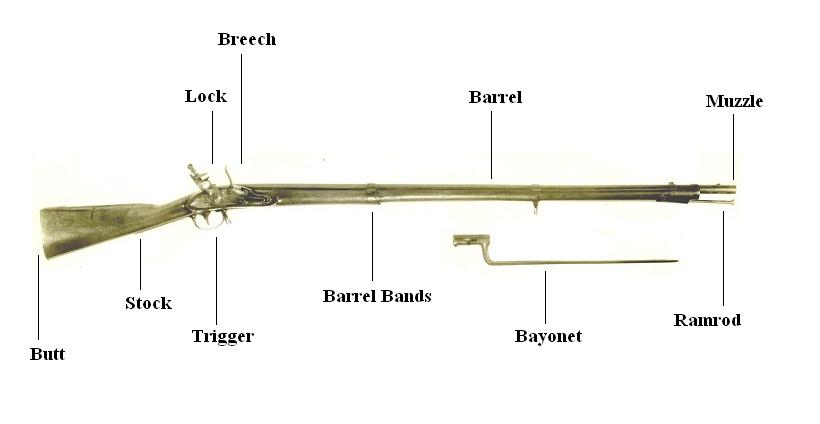
|
| Civil War gun parts and terminology |
Action: The working
mechanism of a firearm. Various types exist, including single-shots, multi-barrels, revolvers, slide- or pump-actions, lever-actions,
bolt-actions, semi-automatics and automatics.
Ammunition: This generally refers to the assembled components
of complete cartridges or rounds i.e., a case or shell holding a primer, a charge of propellant (gunpowder) and a projectile
(bullets in the case of handguns and rifles, multiple pellets or single slugs in shotguns). Sometimes called "fixed ammunition"
to differentiate from components inserted separately in muzzleloaders.
Army: When used to designate a pistol, it means that is a .44 caliber.
Army Revolver: The terms “Army” and “Navy,”
when associated with Civil War revolvers, can appear misleading. “Army” and “Navy” refer only to the
caliber of an arm and in no way indicate its use by a particular branch of the armed forces. Army caliber revolvers are .44
caliber and Navy caliber revolvers are .36 cal. The terms originated with master salesman, Samuel Colt, in an attempt
to enhance the sales of his arms to the two branches of the service.
Artillery: Commonly called cannons. Large bore guns that are mounted on
a carriage or platform that is fired by a crew of soldiers.
Ball: Originally a spherical projectile, now generally a fully
jacketed bullet of cylindrical profile with round or pointed nose. Most commonly used in military terminology.
Barrel: The part of a gun or rifle that is shaped like a tube where the
bullet travels through on the way out of the weapon.
Black Powder: An explosive mixture
of potassium nitrate or sodium nitrate, charcoal, and sulfur used as a propellant in early firearms. The earliest type of
firearms propellant that has generally been replaced by smokeless powder except
for use in muzzleloaders and older breechloading guns that demand its lower pressure levels.
Bolt-Action: A gun mechanism activated by manual operation of the breechblock
that resembles a common door bolt.
Bore: The inside of the barrel where the bullet goes.
Breech: The rear of the barrel.
Breechloading: The breechloading system allowed both projectile and gunpowder
to be inserted into the gun through the breech or back end of the barrel. Breechloading significantly decreased loading time.
Breech Loader: A black powder firearm that loads from the rear of the barrel.
Bullet: The projectile that is shot from a firearm. It is not synonymous
with cartridge. Bullets can be of many materials, shapes, weights and constructions such as solid lead, lead with a jacket
of harder metal, round-nosed, flat-nosed, hollow-pointed, etc.
| Rifle Glossary and Terminology |
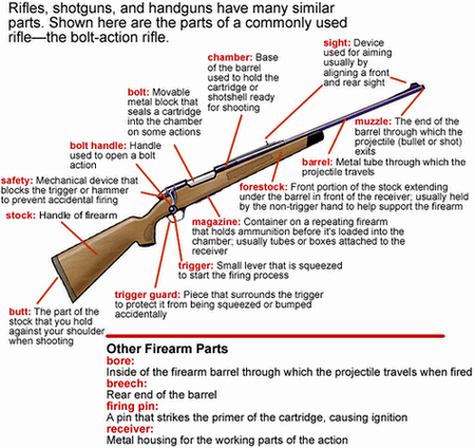
|
| Parts of a Rifle |
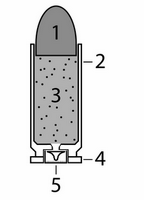
|
| Civil War Cartridge |
(Right) Cartridge, modern
A modern cartridge consists of the following:
1. the bullet, as the projectile;
2. the case, which
holds all parts together;
3. the propellant, for example gunpowder or cordite;
4. the rim, which provides the
extractor on the firearm a place to grip the casing to remove it from the chamber once fired;
5. the primer, which ignites the propellant.
Caliber: The size of bullet.
Carbine: A short lightweight rifle that is intended for use on horseback.
Cartridge: Synonym for Round. A cartridge (also called a round or a shell) is a type of ammunition
packaging a bullet, a propellant substance (usually either smokeless powder or black powder) and a primer within a metallic,
paper, or plastic case that is precisely made to fit within the firing chamber of a firearm.
Case or Casing: The envelope (container) of a cartridge. For rifles and handguns it is usually
of brass or other metal; for shotguns it is usually of paper or plastic with a metal head and is more often called a "shell."
Cavalry: A type of soldier that fights on horseback.
Clip: A device for holding a group of cartridges. A detachable magazine
or separate device for holding and transferring a group of cartridges to a fixed or detachable magazine, or as a device inserted
with cartridges into the mechanism of a firearm becoming, in effect, part of that mechanism.
Collodion: Flammable liquid coating used on some small arms cartridge cases
to make them waterproof. Also frequently used as a means to reinforce the joint between the bullet and the powder charge.
Made by dissolving nitrated cellulose in a mixture of alcohol and ether.
Cone: The part of a gun where the percussion cap is placed to fire the weapon.
Cylinder: The
drum of a revolver that contains the chambers for the ammunition; The round part
of a revolver which sits in the frame that holds the bullets.
Double Action: An action is the way a weapon is fired. A double action means
that the weapon can be fired two ways. For example, the hammer can be cocked by hand and then the trigger pulled to fire it
or the trigger can be pulled which will cock the hammer and fire the weapon.
Double Barrel: A firearm that has two barrels.
Dragoon: Originally, dragoons were soldiers who moved around on horseback
but fought on foot like infantry. By the 1840s, United States Dragoons were evolving into cavalry with guns and swords they
could use on horseback. When the word dragoon is used to designate a type of revolver, it refers
the powerful pistols meant to be carried on a saddle rather than on a man's belt.
Edged Weapon: Bayonets, sabers, swords, short swords, cutlasses, Bowie knives,
pikes, lances, and any device or instrument with a sharp edge.
Ejecting Rod: The part of a metallic cartridge firearm that is used to remove
a spent round so it can be reloaded.
Firearm: A firearm is a weapon from which a shot is discharged by gunpowder
—usually small arms known as gun, weapon, rifle, pistol, handgun, or revolver.
Flash Hider or Flash Suppressor: A muzzle attachment intended to reduce visible muzzle flash
caused by the burning propellant.
Flint: A type of rock that creates sparks well.
Flintlock: A type of lock that uses flint to hit a piece of steel to create
a spark which ignites the black powder in the pan. (A picture of the lock with the names of the parts would be beneficial
here)
Forearm: The wood part of a rifle or shotgun that is under the barrel. It
helps protect the hand from the heat of the barrel when firing.
Frame: The central part of a revolver that holds the barrel, cylinder, and
handle together. On a repeating rifle or shotgun, it is the part that the loading gate is in and holds that barrel and stock
together.
Friction Primers: This is the ignition system for a piece of artillery
during the Civil War. A friction primer is a brass tube filled with fulminated mercury. I twisted brass wire in placed
inside the tube with a looped end hanging out. A string with a hook called a lanyard is placed in the loop and the wire is
yanked out causing friction which creates the explosion necessary for ignition.
Frizzen: An "L" shaped piece of steel hinged at the rear used in flintlock
firearms. The flint scraping the steel causes a shower of sparks to be thrown into the flash pan.
Fulminated Mercury: In
1800 Edward Charles Howard created fulminated mercury. This is prepared by dissolving mercury in nitric acid and adding ethanol
to the solution. The solution was commonly used in caps and friction primers during the 1800s.
Gauge: Unit of measurement used to express the diameter of the barrel.
Grain: Amount of powder in a cartridge or the weight of a bullet.
Gun: A gun is a tubular weapon designed to discharge projectiles,
known as bullets, i.e., revolver, pistol, musket, rifle, carbine, shotgun, handgun, firearm, side arm, etc.
| Parts of a Handgun, aka Pistol or Revolver |
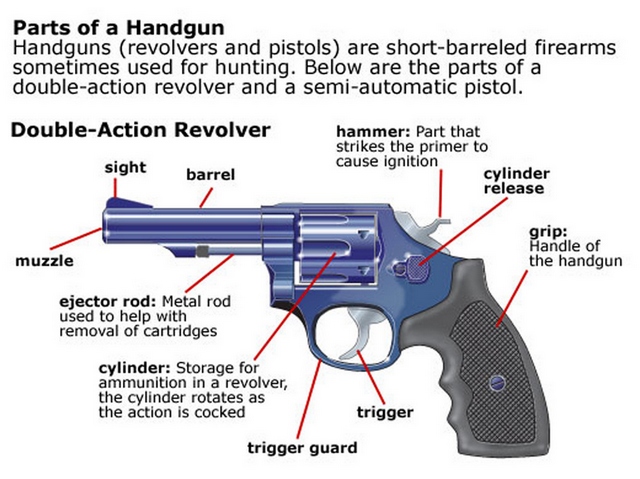
|
| Parts of a Revolver |
Gunpowder: Known also as black powder. It is a mixture
of sulfur, charcoal, and potassium nitrate. It burns rapidly, producing a volume of hot gas made up of carbon dioxide,
water, and nitrogen, and a solid residue of potassium sulfide. Because of its burning properties and the amount of heat and
gas volume that it generates, gunpowder has been widely used as a propellant in firearms.
Hammer: The part of a firearm that is pulled back then released with the
trigger to impact a primer or percussion cap.
Handgun: Smallest of all firearms. See Revolver and Pistol..
Hollow-Point Bullet: A bullet with a concavity in its nose to increase expansion on penetration of
a solid target.
Jacket: The envelope enclosing the core of a bullet.
Lead: A type of soft metal and heavy that is used for bullets. Because it
is soft, it does not damage a firearm the way harder metals would.
Lever Action: A gun mechanism activated by manual operation of a lever.
An action is the way a weapon is fired. A lever action uses a lever to eject a spent cartridge and reload a new one. In most
cases, it also cocks the hammer.
Loading Gate: The place where cartridges are inserted to load a firearm.
Lock: The mechanical part of a firearm that makes it shoot.
Long Gun: Any firearm that is larger than a handgun and is designed to be
held and fired with both hands, either from the hip or the shoulder.
Machine Gun: A firearm of military significance, often crew-served, that on trigger depression automatically
feeds and fires cartridges of rifle size or greater.
Magazine: A spring-loaded container for cartridges that may be an integral part of the gun`s mechanism
or may be detachable. Detachable magazines for the same gun may be offered by the gun`s manufacturer or other manufacturers
with various capacities. A gun with a five-shot detachable magazine, for instance, may be fitted with a magazine holding 10,
20, or 50 or more rounds. Box magazines are most commonly located under the receiver with the cartridges stacked vertically.
Tube or tubular magazines run through the stock or under the barrel with the cartridges lying horizontally. Drum magazines
hold their cartridges in a circular mode. A magazine can also mean a secure storage place for ammunition or explosives.
Metallic Cartridge: A brass or copper container that holds a primer, powder,
and bullet.
Minie Ball: The miniť ball, aka Minnie ball, is a conical shaped lead
bullet that normally has a hollow base. It is slightly smaller than the firearms barrel's bore, making it easier to push it
down the barrel with the ramrod. It has exterior grease-filled grooves to assist in loading the weapon. The bullet was created
by Claude Etienne Miniť, hence the name miniť ball This type of bullet first saw use in the Crimean War and saw its most extensive
use in the Civil War.
Multi-Barreled: A gun with more than one barrel, the most common being the double-barreled shotgun.
Musket: A musket is a long barreled smoothbore firearms used by the infantry.
Muzzle: The open end of a firearm's barrel.
Muzzleloader: A firearm the loads from the the muzzle of a barrel.
Muzzleloading: The muzzleloading system requires both the gunpowder
and projectile to be inserted into the arm through the muzzle or front end of the barrel. Muzzleloading weapons were the standard
issue to soldiers worldwide prior to and during the American Civil War.
Navy: When used to designate a pistol it means that it is .36 caliber.
Navy Revolver: The terms “Army” and “Navy,” when
associated with Civil War revolvers, can appear misleading. “Army” and “Navy” refer only to the caliber
of an arm and in no way indicate its use by a particular branch of the armed forces. Army caliber revolvers are .44 caliber
and Navy caliber revolvers are .36 cal. The terms originated with master salesman, Samuel Colt, in an attempt to enhance
the sales of his arms to the two branches of the service.
Paper Cartridge: Before metallic cartridges were invented the fastest
way to load a firearm was with a paper tube filled with black powder and a bullet. The paper had to
be torn open with the teeth then some of the powder would be poured into the pan if it was a flintlock. The remaining amount
would be poured into the barrel and then the bullet pushed down with the ramrod. The paper would be the wadding that prevented
it all from falling out.
Pellets: Small spherical projectiles loaded in shotshells and more often called "shot." See also
Shot.
Percussion Arms: Percussion means “striking” in music as well
as in weaponry. Civil War small arms commonly used a small brass “cap” which contained a small amount of fulminate
of mercury, a very volatile substance, to ignite the gunpowder charge which fired the weapon. A cap was placed on a cone or
“nipple” that was mounted on the firearm in an area directly adjacent to the chamber. When loaded, the chamber
contained the charge of black gun powder necessary to fire the bullet. The cap was the striking point of the firearm’s
hammer. The resulting percussion of the hammer strike caused the fulminate to explode, sending a tiny flame through a hole
in the cone and into the powder charge. About 100 of these caps could be carried in a small leather pouch attached to a soldier’s
belt. Each bullet fired required a new cap.
Percussion Cap: A cylinder shaped piece of brass or copper that is filled
with fulminated mercury. When hit by a hammer it explodes, forcing flame into the barrel, causing ignition. The first US army
weapon to use this ignition system was the 1819 Hall.
Piece: Slang for firearm.
Pinfire: The pinfire cartridge was invented Casimir Lefaucheux in 1828.
It consists of a rimless casing that is filled with black powder with a percussion cap on the inside. A pin sticks out of
the side of the casing and when the hammer hits it the pin is driven into the cap, causing ignition of the powder.
Pistol: A firearm intended to be fired with one hand. This is often referred
to as a handgun. See also Handgun and Revolver.
Pistol Grip: The handle of a handgun or protrusion on the buttstock or fore-end of a shoulder-operated
gun that resembles the grip or handle of a handgun.
Powder: Powder is the name given to a number of propellants used in firearms.
Primer: A part of a weapons firing
system that ignites powder to discharge the firearm. The ignition component of a cartridge, generally made up of a metallic
fulminate or (currently) lead styphnate.
Projectile: Anything that comes out of a barrel at high speed. Some examples
of projectiles are cannon balls, bullets, and shot.
| Civil War sidearm glossary |
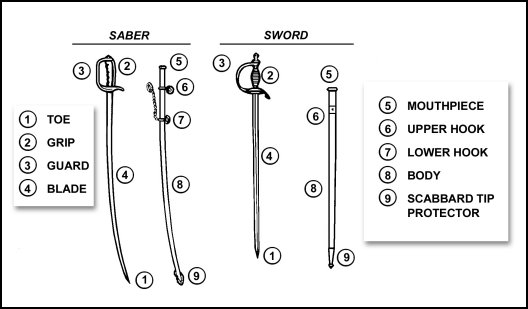
|
| Names of parts of Civil War sword, saber, and respective scabbards |
Propellant: Both smokeless and black powder are propellants. It is a chemical
substance that explodes and creates pressure in an enclosed space such as a barrel to force out a projectile at high speed.
Ramrod: The part of a muzzle loading firearm used to push the bullet down
the barrel. It is stored under the barrel so it can be easily removed to reload the weapon.
Rate of fire: The frequency at which a firearm can fire its projectiles.
Receiver: The housing for a firearm's breech (portion of the barrel with chamber into which a
cartridge or projectile is loaded) and firing mechanism.
Recoil: Backward momentum of a gun
when it is discharged.
Repeater: A type of firearm that has one barrel that holds several cartridges
so that is can be fired quickly.
Revolver: A revolver is a hand-held firearm which includes a cylinder
with a number of chambers (usually 6) containing cartridges. The cartridges were fired one at a time. During the Civil War,
revolvers were issued primarily to cavalrymen, although some light artillerymen also carried them. Because of its convenient
size and weight, the revolver was the weapon preferred by most officers. See also Handgun and Pistol.
Rifle: A firearm that has twisted grooves
inside the barrel or a shoulder gun with rifled bore. These grooves make the bullet spin like a well thrown football
making the weapon fire further and more accurately.
Rifled Musket: Synonym for Rifle-Musket. A rifled musket is type of weapon
made in the mid-19th century. Originally rifled muskets only referred firearms that had a smoothbore barrel that had rifling
added latter. Later, this term designated rifles that were of the same design as a smoothbore musket.
Rifling: The grooves inside of a barrel. Spiral grooves
in a gun`s bore that spin the projectile in flight and impart accuracy. Rifling is present in all true rifles, in most handguns
and in some shotgun barrels designed for increasing the accuracy potential of slugs (a slug is a single projectile rather
than the more common "shot".)
Rimfire: A type of metallic cartridge that has the fulminated mercury added
to the entire outer base of the round. The hammer can hit any part of the rear of the bullet and it will fire. .22 caliber
cartridges still use this type of technology.
Round: Synonym for cartridge.
Sabot: A lightweight carrier surrounding a heavier projectile
of reduced caliber, allowing a firearm to shoot ammunition for which it is not chambered. For example, a hunter could use
his .30-30 deer rifle to shoot small game with .22 centerfire bullets.
Sawed-off Shotgun: A conventional shotgun with barrel
less than 18".
Shot: A projectile that a shotgun fires. It consists several small
lead or steel balls that fires out of a shotgun at once. See also "Pellets"
Shotgun: A smoothbore firearm the fires shot. A shoulder gun
with smooth-bored barrel(s) primarily intended for firing multiple small, round projectiles, (shot, birdshot, pellets), larger
shot (buck shot), single round balls (pumpkin balls) and cylindrical slugs. Some shotgun barrels have rifling to give better
accuracy with slugs or greater pattern spread to birdshot. Used generally by Confederate cavalry because it lacked rifles
and carbines. Shotguns are the preferred tool for hunting birds and small game.
Side arm or Sidearm: Weapon, usually a handgun but sometimes a dagger, knife
or other melee weapon, which is worn on the body in a holster to permit immediate access and use.
Single Action: An action is the way a weapon is fired. A single action
can only be fired one way. In most cases it means that a hammer must be cocked manually to make it ready to fire.
Later, weapons were made with the hammers covered that only fired by squeezing the trigger. These are also single action.
Single-shot: A firearm that holds only a single round of ammunition, and
must be reloaded after each shot.
Slide-Action: A gun mechanism activated by manual operation of a horizontally sliding handle almost
always located under the barrel. "Pump-action" and "trombone" are synonyms for "slide-action."
Smoothbore: A barrel that is completely smooth on the inside.
Snub-Nosed: Descriptive of (usually) a revolver with an unusually short barrel.
Stock: The part of a rifle or other firearm, to which the barrel and firing
mechanism are attached, that is held against one's shoulder when firing the gun. The stock provides a means for the shooter
to firmly support the device and easily aim it. During the 1800s it was the wood part of a rifle, musket, shotgun, or carbine
that holds all the parts of the weapon together and gave a place to put on the shoulder of a shooter.
Swage: To reduce an item in size by forcing through a die. In internal ballistics,
swaging refers to the process where bullets are swaged into the rifling of the barrel by the force of the expanding powder
gases.
Swaged: A sizing process used on cast bullets. A bullet was placed in a metal cylinder of the
desired shape and diameter. A punch the shape of the cavity followed and was struck with a hammer. This action swaged the
bullet to proper diameter and shape. The bullet was dislodged by hitting a punch at the nose of the bullet.
Swaged bullet: A bullet that is formed by forcing the bullet into a die to assume its final form.
Swaged choke: A constriction or choke in a shotgun barrel formed by a swaging process that compresses
the outside of the barrel.
Swaged Rifling: Rifling in a firearm barrel formed by a swaging process, such as button rifling.
Trapdoor: The breech loading mechanism of a single shot military rifle.
Trigger: A small straight piece of metal that is squeezed the make a weapon
fire.
Weapon: Device capable of inflicting "grave bodily harm." During the Civil War it referred to firearm, but
also included "Edged Weapons."
Windage: The side-to-side adjustment of a sight, used to change the horizontal component of the aiming point.
Zero-in or Zeroing: The act of setting up a telescopic or other sighting system so that the point of impact
of a bullet matches the sights at a specified distance.
See also
|

|

|

